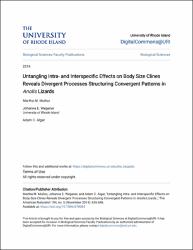Mostrar el registro sencillo del ítem
Untangling intra-and interspecific effects on body size clines reveals divergent processes structuring convergent patterns in Anolis lizards
| Licencia | This article is brought to you for free and open access by the Biological Sciences at DigitalCommons@URI. It has been accepted for inclusion in Biological Sciences Faculty Publications by an authorized administrator of DigitalCommons@URI. | es |
| Autor | Muñoz, Martha M. | |
| Autor | Wegener, Johanna E. | |
| Autor | Algar, Adam C. | |
| Fecha de admisión | 2022-09-03T13:30:32Z | |
| Fecha disponible | 2022-09-03T13:30:32Z | |
| Año | 2014 | |
| Citación | Muñoz, M. M., Wegener, J. E., & Algar, A. C. (2014). Untangling intra-and interspecific effects on body size clines reveals divergent processes structuring convergent patterns in Anolis lizards. The American Naturalist, 184(5), 636-646. Recuperado de: | es |
| URI | https://bvearmb.do/handle/123456789/1474 | |
| Sinopsis | Bergmann’s rule—the tendency for body size to increase in colder environments—remains controversial today, despite 150 years of research. Considerable debate has revolved around whether the rule applies within or among species. However, this debate has generally not considered that clade-level relationships are caused by both intra- and interspecific effects. In this article, we implement a novel approach that allows for the separation of intra- and interspecific components of trait-environment relationships. We apply this approach to body size clines in two Caribbean clades of Anolis lizards and discover that their similar body size gradients are constructed in very different ways. | es |
| Idioma | English | es |
| Publicado | The American Naturalist, 184(5), 636-646 | es |
| Derechos | © 2014 by The University of Chicago. | es |
| Materia | Ecología | es |
| Materia | Fauna ─ República Dominicana | es |
| Materia | Hábitats y especies | es |
| Título | Untangling intra-and interspecific effects on body size clines reveals divergent processes structuring convergent patterns in Anolis lizards | es |
| dc.identifier.doi | 10.1086/678084 | |
| Tipo de material | Article | es |
| Tipo de contenido | Scientific research | es |
| Acceso | Open | es |
| Audiencia | Technicians, professionals and scientists | es |
Ficheros en el ítem
Este ítem aparece en la(s) siguiente(s) colección(es)
-
Investigación ambiental [1759]


